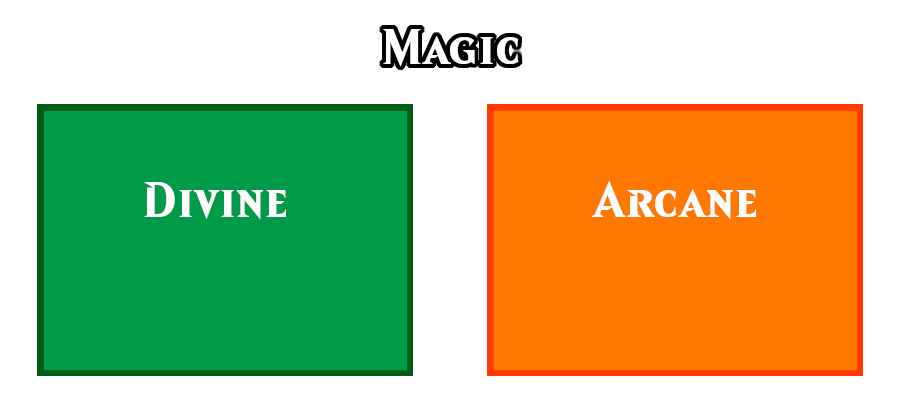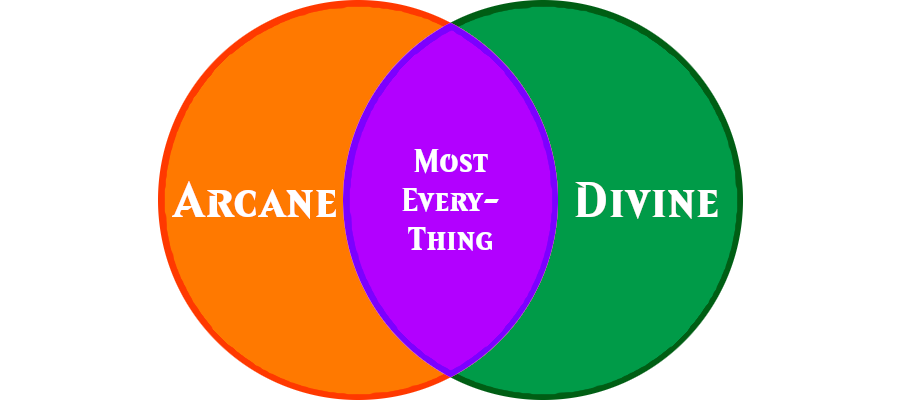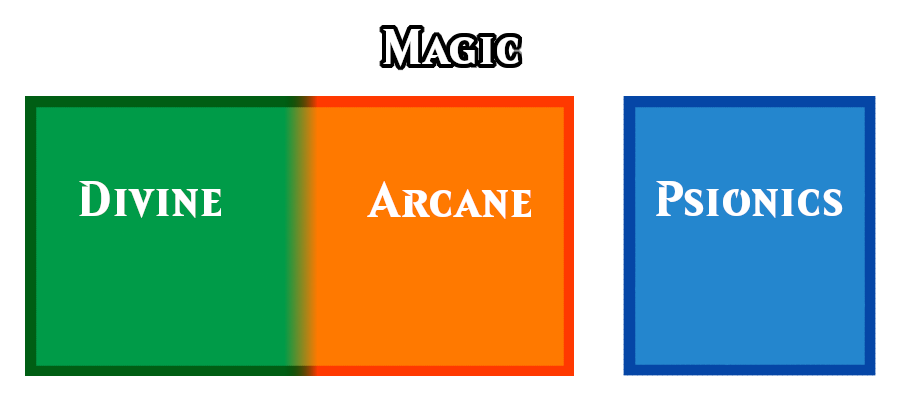What’s the difference between Arcane magic and Divine magic?
Familiar as I am with 3rd edition, I know there’s definitely a structure that says Arcane magic is the slightly more powerful one, and that Divine magic is easier and more convenient to use out of the box, but that’s the perspective from one extremely bleeding edge level of power that I never really got to play with. My experience of wizards and clerics in 3rd edition were always characters who did that and something else, in order to keep their power level meaningfully contained. Basically, I liked a wizard with a sword or a cleric with a pet rather than just taking my Busted Spellcaster Classes straight.
Until 4th edition approached and rebuilt every power source with a specific holistic vision for the shared traits of powers, Arcane magic and Divine magic existed as parts of a continuum that shaped your vision of the world at large. And the machinery of the game was designed to get people involved at one point and you were meant to grow as a player while you did.
What, then, was the difference?
Purest, simplest, core distinction between the two is that in the player’s handbook, Arcane spells experience ‘arcane spell failure,’ which means that when you’re wearing armour, arcane spells have a chance to fail based on how heavy the armour is. Wizards, you’re told, do this complicated magic that needs a lot of components to work, and need rest and a spellbook to set up their spells ahead of time, while the cleric just gets their spells refreshed once a day depending on the rituals of their god.
The spell lists are presented separately and differently. The wizard spell lists are formatted by level and school, to relate to the wizard’s specialisation class feature. The cleric spell list, on the other hand, is just all the spells in that list, by level, and the bard, cleric and paladin spell lists are similarly isolated. Individual spells tell you that they exist on spell lists and where, and you can use that to see what kinds of traits those schools of magic have in common or different.
The first impression the rules try to present then, is that there’s a very clear distinction between these spell lists, but then that distinction is almost immediately dissolved when you start looking at actual spells. Clerics have spells that blast thing with damage from a distance, wizards have spells that turn you into a damage dealer. At first impression, and in the early days of 3rd edition, you could get arcane spellcasting separated from divine spellcasting primarily because arcane magic couldn’t heal things. In 3.5, that was changed thanks to the bard gaining healing spells.
Then, as the game progressed you’d realise that slowly but surely, divine spells would get single individual exceptions to their flavour, so that a divine spellcaster eventually had access to fireball and an arcane spellcaster eventually had access to cure light wounds and only the most fringe stuff lay exclusively in one domain or the other. Differences were extremely specific, and 10d8 damage in a line vs 8d10 in a column are definitely meaningfully different but they don’t make the magic itself feel different.
Part of this kind of blurring intersection was that the two forms of magic were, good or ill, in the game at base and constantly being expanded. Every single individual tradition, every new location, every expansion could add a spell or two to both sides of the ledger, and that meant that over time, their commonalities were pretty universal and their differences were pretty irrelevant. But on the other hand, there was another part of the magic system which was not included all the time and therefore, had potential to be completely separated – and to be kept completely separated.
That was the psionics system, which in addition to working differently on a fundamental level, was also not supposed to interact much with the other two types. The 3e system of healing for psionic characters was weird and inefficient, with the ardent doing things like taking damage onto themselves then recovering it personally, and that at least meant that a healing spell wasn’t as valid for a wizard as it was for a cleric.
The result meant that over time the psionics system was able to stand apart from the other two systems, and had its own specific flavour… at least until they started expermenting with 3.5 magic systems. Oh, a bunch of the experimentation was bad – the Binder, the Truenamer, the Shadow Mage, the Warlock for example. They were saved from their encroachment in this middle space, though by dint of being so shit nobody ever really tried expanding on them.
What makes them more complicated is that they weren’t really clear on why they were the flavour they were. Shadow magic, tapping a dimension, an external force. Totemists in the Incarnum system – Incarnum, oh yeah, Incarnum was in there too, but all these minor systems were just swirling around impossibly inspecific things that felt like magic so they were magic, and forced to fit into the complicated space of these three (two? One and a half?) categories.
Then there’s the way that specific settings handled it. In The Forgotten Realms, for example, magic was done by manipulating the Weave. The Weave was so important to magic that the gods themselves used it to do their spells, and since there was a god who controlled the weave, there was, hypothetically at least, a power imbalance where every divine spell was also, kinda an arcane spell. In some worlds, psionics was just another type of magic literally, and in other worlds, arcane magic was playing with the interaction of divine magic swilling around.
It’s a problem, I feel, with how these magics work in the older system. Flavour could make demands, but it almost always came to the mechanical system which simply didn’t have any meaningful separation between them. I guess the lesson here is that a clarity of purpose, an idea of how things should be, is important to the enforcement of the system’s development.



